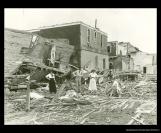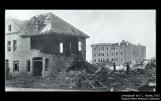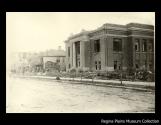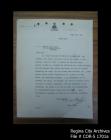1
Human Injury and Loss of Life3
The severity of a tornado is rated by the amount of destruction it causes. The tornado had a huge impact on the city's physical environment. Businesses, homes and other buildings were destroyed, streets were blocked and thousands were left homeless. While damaged buildings can be repaired or replaced, there is no replacement for the loss of human life. Even if no buildings had been damaged during the Regina tornado of 1912, the 28 lives lost during the storm along with the hundreds of injured would still make it the most destructive tornado in Canadian history.5
A tornado's destructive power is made apparent when high speed winds break apart objects, creating debris and missiles that become airborne. The most innocuous and everyday materials - wood, bricks, metal - become deadly weapons when harnessed by a tornado. It is these materials that cause injury and death.Where there are people, there are almost always buildings, and it is this combination that makes tornadoes and other natural disasters so deadly. Even before the tornado had entered the more densely built areas of Regina proper, it claimed the life of Andrew Roy, who was visiting the home of Robert Kerr, just outside the city. It is worth noting that in 1912, a farm just outside the city would be located roughly where the Southland Shopping Centre is located today.
The greatest loss of life (and injury) occured on Lorne and Smith streets, which were along the main path of the tornado. These streets were mainly residential, with many people and buildings in a condensed area.
7
In his book "Regina's Terrible Tornado", Frank W. Anderson records that in all, 28 people lost their lives to the tornado:Andrew Roy - visiting the home of Andrew Kerr, just outisde the city
Philip Steel - Wascana park
Vincent H. Smith - found on Smith Street, was thought to be at the Regina Boat Club House when the storm hit
James Patrick Coffee - 2202 Lorne Street
Andrew Boyd - 2202 Lorne Street (lived for 2 days after the storm)
Donal Miller Loggie - 2201 Smith Street
Mrs. McElmoye - 2318 15th Avenue
Etta Guthrie - 2138 Lorne Street
Mrs. Harris - 2138 Lorne Street
Ywe Boyuen - Smith Street and 13th Avenue, Mack Lee's Chinese Laundry
Isabelle McKay - 1947 Smith Street
Charles McKay (3 years old) - 1947 Smith Street
Lawrence Hodsman - 1947 Smith Street
Arthur Donaldson - 1947 Smith Street
Frank Blenkhorn - found between the Methodist Parsonage and the Carnegie Library, on Lorne Street
Bertha Blenkhorn - found between the Methodist Parsonage and the Carnegie Library, on Lorne Street
Mary Shaw - 2320 12th Avenue
James Milton Scott - Donahue Block
Charlie Sand - 1821 Cornwall Street, Ma Chang Sing Laundry
Ye Wing - 1821 Cornwall Street, Ma Chang Sing Laundry
Robert Fenwick - found in the Palace Livery on Dewdney Avenue
Joseph J. Bryan - Tudhope Anderson Warehouse
George B. Craven - found near the Canadian Pacific Railway roundhouse
Laura McDonald - 1435 Lorne Street N
James McDougall - 1435 Lorne Street N
Ida McDougall (3 years old) - 1435 Lorne Street N
George Appleby - behind a house on Cornwall Street, between 7th and 8th Avenue
Other sources do indicate that more deaths occured, but the identity of those killed has not been determined.
8
Postcard depicting damage on Lorne Street, with two lost dogs in the foreground.1912
Lorne Street, Regina, Saskatchewan
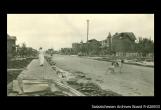
9
Some of the victims of the tornado were harder to recognize - as illustrated in the account on the back of one postcard:"This is Lorne St. or rather what was left of it. The two dogs were fast friends of ours. They are looking for their house which does not now exist."
It is not known what happened to the owner of the two dogs, but it is easy to imagine that they may have been distracted in the days following the tornado.
11
The citizens of Regina mourned the loss of its community members in the days following the tornado. As letters of inquiry poured into the city, City Clerk A.W. Pool had the unfortunate duty of informing relatives about the death of a beloved Regina citizen:"Dear Sir:
In reply to yours of the fifth, instr. which his Worship, the Mayor, has handed to me for reply, I very greatly regret to have to inform you that the Scout Master Appleby you mention was killed in the recent disaster, and his funeral took place yesterday. The Sons of England arranging for the same. The Boy Scouts also attended, and a large number of the public followed on as Mr. Appleby was well known, and respected locally. I am instructed, by his Worship, the Mayor, to express, the deepest sympathy of the Citizens of Regina, generall, with all the relatives of the deceased. His death so far as is known as instantaneous, he being pinned under a huge pile of debris. Again extending my sympathy and that of the Citizens, generally,
I am,
Yours Turly,
A.W. Pool
City Clerk"
George Appleby was camped in a tent outside of a house on Cornwall Street, and was crushed by a falling all. George Appleby was the last known victim in what has remained the most destructive tornado in Canadian history.
12
Text by Jaymie KorolukRegina Plains Museum
